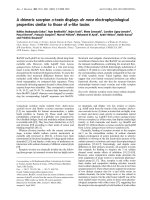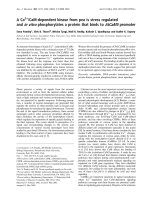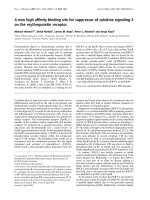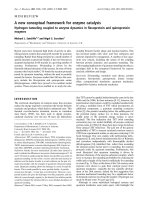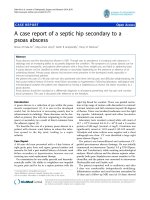Báo cáo y học: " A new device to seal large coronary aneurysms: a case report." docx
Bạn đang xem bản rút gọn của tài liệu. Xem và tải ngay bản đầy đủ của tài liệu tại đây (645.83 KB, 4 trang )
CAS E REP O R T Open Access
A new device to seal large coronary aneurysms: a
case report
Gian Battista Danzi, Guido Angelo Pomidossi
1
, Filippo Casolo
1
, Marco Centola
1
, Roberto Ferraresi
1
, Chaim Lotan
2
Abstract
Introduction: Coronary artery aneurysm is an uncommon disease. It is defined as a coronary artery dilatation,
exceeding the diameter of the normal adjacent segment or the diameter of the patient’s largest coronary vessel by
1.5 to 2 times. Coronary artery aneurysms are typically diagnosed by coronary angiography. The prognosis of
coronary artery aneurysm is not well known and the management is challenging.
Case presentation: A 68-year-old Italian-Caucasian man presented to our hospital with angina. Coronary
angiography revealed a large coronary aneurysm of the right coronary artery, which was successfully treated by
the percutaneous implantation of an MGuard™stent.
Conclusion: This case report provides evidence that coronary artery aneurysms, even if very large, can be safely
treated by MGuard™stent implantation. We strongly emphasize the high flexibility and good deliverabil ity of this
device, which leads to the complete exclusion of the aneurysm mediated by the process of endothelization of its
thin mesh sleeves.
Introduction
Coronary artery aneurysm is a rare disorder character-
ized by an abnormal dilatation (diameter >50% of the
normal adjacent segments) of a lo calized or diffuse por-
tion of the coronary artery [1,2]. The detected incidence
on angiography varies from 0.3% to 4.9% in large studies
[1,2]. Atherosclerosis is the most common etiology esti-
mated at 50% of cases diagnosed in adults; independent
of the etiology, the aneurysmal segment produces turbu-
lent blood flow with an increased incidence of myocar-
dial ischemic manifestations (acute coronary syndromes,
thromboembolism, rupture or vasospasm) [3-5]. The
indication for treatment and the best modalities still
need to be defined [6]. In recent years different studies
have reported the treatment of coronary aneurysm with
the polytetrafluoroethylene (PTFE) covered stents as a
valuable alternative to surgery in selected cases (dia-
meter six to 10mm) [7,8]. However, the use of this
device is limited by its dimension, by the low flexibility
(that makes i mplantation very difficult in tortuous ves-
sels), by the lack of access of side branches and by the
inherent risk of restenosis. The MGuard™ stent (Inspir-
eMD Ltd, Tel Aviv, I srael) is a novel coronary device
composed of a multicellular stainle ss steel stent with an
integrated polyethylene terephthalate ( PET) protective
sleeve mesh (15 μm single PET knit fiber with 150 μm
×150μm apertures) (Figure 1a). The sleeve acts as a
snowshoe, averaging the expansion impact while pre-
venting embolic dislodgment. This stent has a high flex-
ibility and a low profile that can challenge very complex
anatomies; the process of endothelization of this device
transforms the mesh sleeve into a membrane that has
the potential to seal coronary aneurysms [9,10].
Case presentation
A 68-year-old Italian-Caucasian man who had a pre-
vious angioplasty to an obtuse marginal branch pre-
sented to our institution for angina and a positive
myocardial perfusion imaging test (reversible perfusion
defects on inferior wall). An angiography showed a
patent stent on obtuse marginal artery and a large cor-
onary aneurysm of the right coronary artery (6.7 mm in
diameter and 15.2 mm in length) (Figure 1b; additional
file 1)[1,2]. A 3.5 to 24 mm lo ng MGuard™ stent was
implanted, using a pressure of 16 bar (additional file 2).
After stent deployment, the injection of dye showed par-
tial opacification of the aneurysmal sac through the
holes of the net, with some stagnation of blood (Figure
* Correspondence:
Danzi et al. Journal of Medical Case Reports 2010, 4:238
/>JOURNAL OF MEDICAL
CASE REPORTS
© 2010 Danzi et al ; licensee BioMed Central Ltd. This is an Open Access article distributed under the term s of the Cre ative Commons
Attribution License ( which permits u nrestricted use, distribution, and reproduction in
any medium , provided the original work is properly cited.
AB
CD
E
F
Figure 1 Coronary angiography and CT scan before and after MGuard stent implantaion. (A) The unexpanded (top) and the expanded
stent covered with a sleeve mesh (bottom). Reproduced with permission from InspireMD. (B) Angiography of the right coronary artery with the
presence of a large saccular aneurysm involving the distal part of the artery to the crux cordis. (C) Partial opacification of the aneurysmal sac
through the holes of the mesh just after stent implantation. (D) Coronary angiography at one month follow-up showing the exclusion of the
aneurysm. (E) Coronary CT scan at one month: multiplanar reformation of the right coronary artery near the crux cordis; on the right ventricle
side of the distal part of the stent, is clearly demonstrated the water density remnant of the treated aneurysm (arrows): low density fat is
surrounding the proximal stent. (F) Coronary CT scan at one month: The magnified view of the stent allows for a better identification of the
treated aneurysm (arrows).
Danzi et al. Journal of Medical Case Reports 2010, 4:238
/>Page 2 of 4
1c; additional file 3). His hospital stay was uneventful
and our patient was discharged the day after the proce-
dure with dual anti-platelet therapy. At one month our
patient was totally asymptomatic. The coronary com-
puted tomography (CT) scan showed a good stent appo-
sition (Figure 1e,f) with complete exclusion of the
aneurysm that was also confirmed by angiography (Fig-
ure 1d; additional file 4).
Conclusions
Coronary artery aneurysms may be complicated by
thrombosis and rupture. The optimal treatment
options of coronary aneurysms are still largely debated.
They include anticoagulation, covered stents, recon-
struction, re section and exclusion with bypass [11].
The PTFE-covered stents have been used to treat cor-
onary artery aneurysms, but the restenosis rate and
long-term effectiveness of c overed stents are unknown.
The newly developed balloon-expandable MGuard™ s-
tent system with its combination of an ultra-thin poly-
mer mesh sleeve attached to the external of a bare
metal stent surface has been designed to provide
embolic protection during percutaneous coronary
intervention restenosis by bare metal stents, peripheral
embolism following stent implantation in vein grafts,
and conditions in which there is a discontinuity of the
coronary lumen (rupture or perforation, aneurysm, and
fistula). This device de monstrated e xcellent perfor-
mance in a highly complex lesion subset such as cover
coronary artery perforations or arteriovenous fistulas
with high success and acceptable rates of acute compli-
cations. Based on its technical features, we decided to
use the MGuard™stent to seal a coronary artery aneur-
ysm. This experience suggests a new potential indica-
tion for the use of MGuard™ coronary stent as an
attractive alternative treatment with less risk of in-
stent restenosis. In human coronary arteries the com-
plete exclusion of the aneurysmal sac (that is mediated
by the process of endothelization of the ultra-thin PET
mesh sleeve) is not immediate and seems to require at
least four weeks. The high flexibility and the good deli-
verability make the MGuard™device an attractive alter-
native to the currently available covered stent for an
effective treatment of coronary aneurysm.
Consent
Written informed consent was obtained from the patient
for publication of this case report and any accompany-
ing images. A copy of the written consent is available
for review by the Editor-in-Chief of this journal.
Additional material
Additional file 1: Coronary angiography showing a large coronary
artery aneurysm. Right anterior oblique view of the right coronary
artery with the presence of a large aneurysm involving the distal part of
the artery till the crux cordis.
Additional file 2: MGuard stent implantation. Stent deployment at a
pressure of 16 bar.
Additional file 3: Coronary angiography after stent implantation.
Opacification of the aneurysmal sac through the holes of the net, with
some stagnation of blood.
Additional file 4: Coronary angiography at one month follow up.
Follow-up angiography at one month showing the complete exclusion
of the aneurysmal sac.
Author details
1
Department of Cardiology, I.R C.C.S. Ospedale Maggiore Policlinico, Milano,
Italy.
2
Heart Institute, Hadassah-Hebrew University Medical Center, Jerusalem,
Israel.
Authors’ contributions
The idea of the case report was conceived and executed by GBD. GBD and
GAP interpreted the patient data regarding the cardiac disease. GBD and
GAP decided the clinical strategy and were operators during the coronary
angiography. They wrote the paper. FC analyzed CT scan images and gave
suggestions regarding the images ‘selections. MC and RF were major
contributors in writing the manuscript. Minor changes regarding the
technical features of the device were offered by CL on a scientific level to
ensure accuracy. All authors read and approved the final manuscript.
Competing interests
GBD certifies that GAP, FC, MC, RF, and he have no financial potential
conflicts of interest and no financial relationship with the company that
produces the MGuard stent.
The idea of the case report was conceived and executed by GBD, and his
team with no financial interest affecting the manuscript. The manuscript was
not subject to approval by the company. Minor changes were offered by CL,
on a technical level to ensure accuracy. CL, the co-author of the paper, is a
consultant for Inspire MD, the company that produces the MGuard stent.
Received: 2 December 2008 Accepted: 3 August 2010
Published: 3 August 2010
References
1. Swaye PS, Fisher LD, Litwin P, Vignola PA, Judkins MP, Kemp HG, Mudd JG,
Gosselin AJ: Aneurysmal coronary artery disease. Circulation 1983,
67:134-138.
2. Eng J, Nair KK: Giant coronary aneurysm. J Cardiovasc Surg 1993,
34:339-340.
3. Mushabbar S, Lesch M: Coronary artery aneurysm: a review. Prog
Cardiovasc Dis 1997, 40:77-84.
4. Gurtu R, Uemura H, Tsuda E, Dubrey SW: Giant coronary artery aneurysms
and myocardial infarction: aetiology and management. Br J Hosp Med
2007, 68:618-619.
5. Demopoulos VP, Olympios CD, Fakiolas CN, Pissimissis EG, Economides NM,
Adamopoulou E, Foussas SG, Cokkinos DV: The natural history of
aneurismal coronary artery disease. Heart 1997, 78:136-141.
6. Harandi S, Johnston SB, Wood RE, Roberts WC: Operative therapy of
coronary arterial aneurysm. Am J Cardiol 1999, 83:1290-1293.
7. Briguori C, Saris C, Sivieri G, Takagi T, Di Mario C, Colombo A:
Polytetrfluoroethylene-covered stent and coronary artery aneurysms.
Cathet Cardiovasc Intervent 2002, 55:326-330.
Danzi et al. Journal of Medical Case Reports 2010, 4:238
/>Page 3 of 4
8. Szalat A, Durst R, Cohen A, Lotan C: Use of polytetrfluoroethylene-covered
stent for treatment of coronary artery aneurysm. Cathet Cardiovasc
Intervent 2005, 665:203-208.
9. Kaluski E, Groothuis A, Klapholz M, Seifart P, Edelman E: Coronary stenting
with M-GUARD: feasibility and safety porcine trial. J Invasive Cardiol 2007,
19:326-330.
10. Costa Jde R Jr, Costa R, Feres F, et al: Preliminary Experience with the
Novel MGuardTM Stent System Containing a Protection Net to Prevent
Distal Embolization - Results From a Prospective, Non-Randomized,
Single Center Study. Abstract Circulation 2008, 118:S-745.
11. Everett JE, Burkhart HM: Coronary artery aneurysm: case report. J
Cardiothorac Surg 2008, 3:1.
doi:10.1186/1752-1947-4-238
Cite this article as: Danzi et al.: A new device to seal large coronary
aneurysms: a case report. Journal of Medical Case Reports 2010 4:238.
Submit your next manuscript to BioMed Central
and take full advantage of:
• Convenient online submission
• Thorough peer review
• No space constraints or color figure charges
• Immediate publication on acceptance
• Inclusion in PubMed, CAS, Scopus and Google Scholar
• Research which is freely available for redistribution
Submit your manuscript at
www.biomedcentral.com/submit
Danzi et al. Journal of Medical Case Reports 2010, 4:238
/>Page 4 of 4

